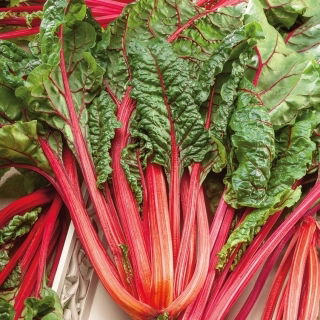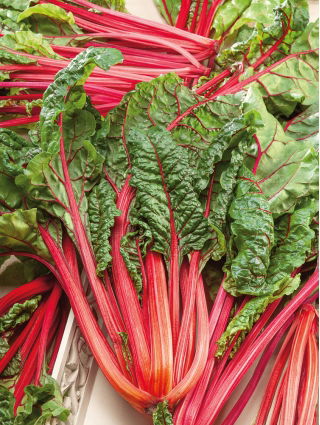BIO Swiss chard - Rhubarb Chard - Striking red stems with glossy dark green leaves - Fresh Seeds
Bio Rhubarb Chard is a distinctive variety of leafy vegetable, characterised by its vibrant colours and culinary versatility. Its juicy, red leaf petioles and dark green, glossy leaves add visual interest to garden beds and contribute fresh flavour to a variety of dishes. Grown from seeds sourced from certified organic cultivation, it ensures healthy, high-quality yields, supporting environmentally friendly gardening practices.
Seed Sowing
Bio Rhubarb Chard is best sown directly into the soil. When selecting a location, ensure the soil is well-drained, fertile, and slightly moist. Prior to sowing, the soil should be thoroughly loosened to facilitate root establishment and nutrient uptake from the soil.
Depth of Sowing
Seeds of Rhubarb Chard are recommended to be planted at a depth of 2-3 cm. This depth protects the seeds from drying out and promotes uniform germination. Lightly firm the soil after sowing to ensure good seed-to-soil contact.
Optimal Sowing Period
The ideal time for sowing Bio Rhubarb Chard is from April to July. Proper timing provides the plants with favourable conditions for growth, resulting in abundant harvests from early summer through late autumn.
Spacing
To allow Rhubarb Chard to develop without obstruction, maintain a spacing of 30-40 cm between rows and 7-8 cm between individual plants. This spacing provides sufficient room for leaf expansion and improves air circulation, reducing the risk of fungal diseases.
Growing Conditions
Rhubarb Chard thrives best in sunny locations or partial shade. It prefers fertile, well-drained soils with a slightly acidic or neutral pH. Regular watering, especially during dry periods, supports healthy growth and prevents excessive leaf wilting.
Cultivation
Bio leafy beet is a low-maintenance plant, but regular weed removal and soil loosening around the plants are recommended. Using natural fertilisers such as compost or biohumus enriches the soil with essential nutrients. Mulching helps retain moisture and suppress weed growth, promoting optimal development.
Harvesting
Harvesting of Rhubarb Chard can begin as early as June and continue through October. It is best to pick young leaves and petioles, which are tender and full of flavour. Regular pruning of leaves encourages further growth, enabling continuous fresh harvests throughout the season.
Uses
Bio Rhubarb Chard is an excellent addition to various culinary dishes. Its young leaves can be eaten raw in salads, while mature leaves and petioles are suitable for stewing, boiling, or frying. It pairs well with garlic, olive oil, and herbs, enhancing soups, stews, and casseroles. The leaf petioles can substitute rhubarb in desserts, offering a subtly tart flavour.
Why Buy from GardenSeedsMarket?
Choosing to purchase Bio Rhubarb Chard seeds from GardenSeedsMarket guarantees a high-quality product. Seeds from certified organic cultivation ensure healthy yields and support sustainable gardening methods. We offer prompt delivery and support throughout the cultivation process. Our satisfied customers" reviews confirm the reliability of our service. Take advantage of our offer and start growing organic vegetables in your garden!
The package contains 10 g of seeds. The packaging includes instructions for cultivation and the sowing deadline.








